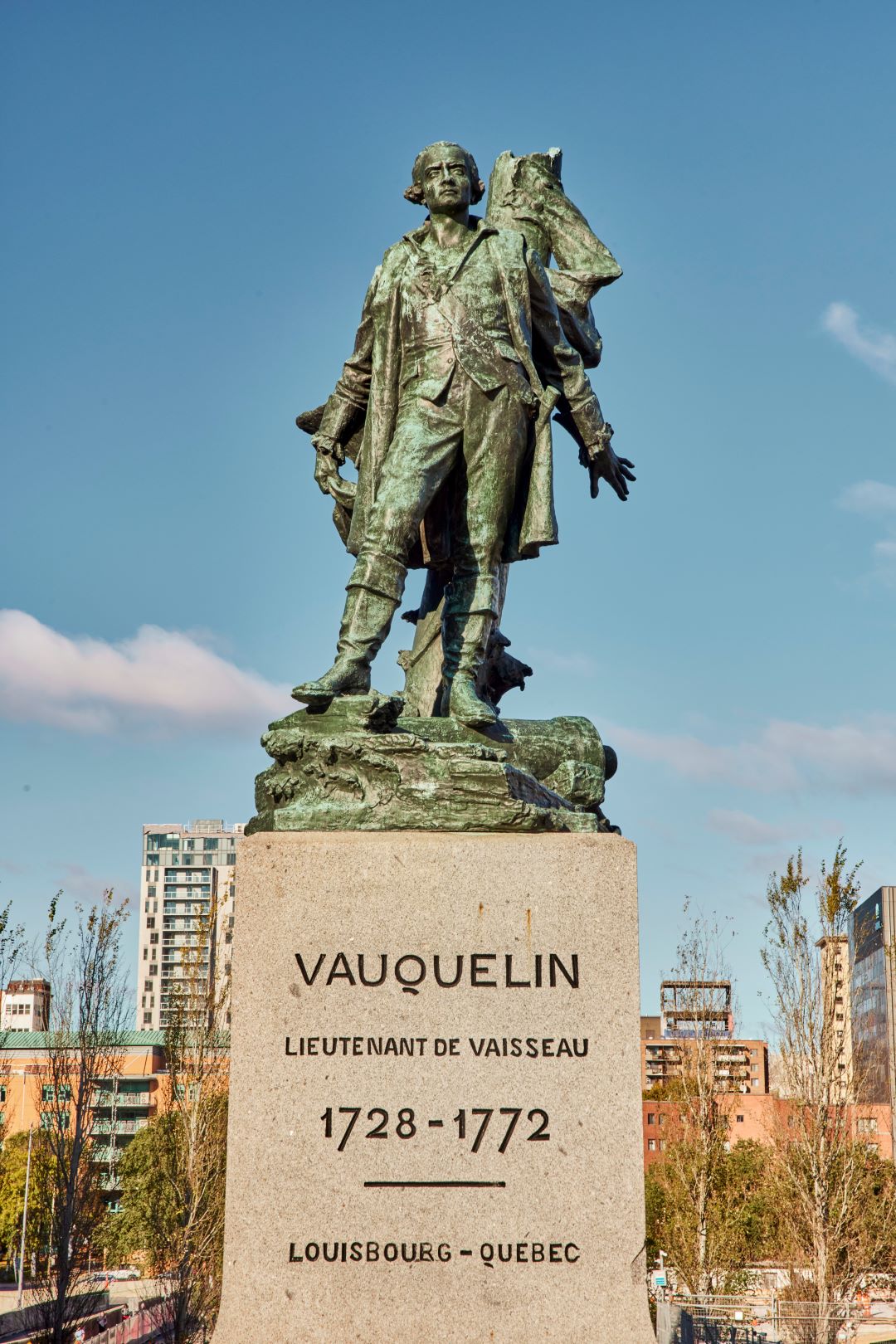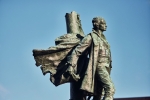Eugène-Paul Benet
Monument à Jean Vauquelin
1927
Presentation of the artwork
The monument is situated in the north part of Place Vauquelin, behind the fountain. The choice of site is strategic, in the axis of Place Jacques-Cartier dominated by the statue of Admiral Nelson, victor in the battle of Trafalgar. Two courageous men, one French and the other English, stand face to face in the public space. This monument draws part of its significance from the statue to which it is the counterpoint.It is a bronze statue placed on a pedestal and base made of grey granite. Vauquelin is portrayed standing, leaning slightly on the broken mast of his ship. His body is melded with the trunk of the mast. His left foot rests on a broken cannon stock. In his right hand he holds part of a flag attached to the mast that he is grasping. His left hand is held out behind him in a protective gesture. The entire work evokes defeat and shipwreck, but the figure holds his head high and gazes ahead with a challenging look. The composition, portraying Vauquelin pushed back to his last retrenchment, contributes to the image of a courageous hero. There are few contextual elements surrounding the figure. The treatment of the statue is conventional and classical in nature.
Associated events
Jean Vauquelin was born in Dieppe in 1728. He quickly became known as an excellent navigator and served as an officer during the War of the Austrian Succession. In 1750, he became a captain in the merchant marine. At the beginning of the Seven Years’ War, he engaged in the battles that were taking place in New France at the time of the Conquest. He distinguished himself at Louisbourg, in 1758, by slowing Wolfe’s advance toward the town of Québec. In 1760, with his frigate the Atalante, he participated in manoeuvres around Québec and held off the English offensive until his munitions were exhausted. He was seriously wounded and taken prisoner. Later repatriated to France, he resumed his naval career in 1764. He died in Rochefort in 1772.
Eugène-Paul Benet
Eugène-Paul Benet was born in Dieppe in 1863. He received his education in sculpture from Laurent Marquestre and Alexandre Falguière. He was awarded medals at the Salon de Paris in 1884, 1897, and 1900. Many of his works are conserved at the museum in Dieppe. His most important monumental artworks in France are the Monument aux morts d'Orbais (Marne) (undated) and the Beaumesnil monument (Eure) (1920), also known as Le Poilu victorieux. He died in Paris in 1942.
Awards and honours
- Médaille du Salon de Paris, 1884
- Médaille du Salon de Paris, 1887
- Médaille du Salon de Paris, 1900
Presentation of the artwork
The monument is situated in the north part of Place Vauquelin, behind the fountain. The choice of site is strategic, in the axis of Place Jacques-Cartier dominated by the statue of Admiral Nelson, victor in the battle of Trafalgar. Two courageous men, one French and the other English, stand face to face in the public space. This monument draws part of its significance from the statue to which it is the counterpoint.It is a bronze statue placed on a pedestal and base made of grey granite. Vauquelin is portrayed standing, leaning slightly on the broken mast of his ship. His body is melded with the trunk of the mast. His left foot rests on a broken cannon stock. In his right hand he holds part of a flag attached to the mast that he is grasping. His left hand is held out behind him in a protective gesture. The entire work evokes defeat and shipwreck, but the figure holds his head high and gazes ahead with a challenging look. The composition, portraying Vauquelin pushed back to his last retrenchment, contributes to the image of a courageous hero. There are few contextual elements surrounding the figure. The treatment of the statue is conventional and classical in nature.
Associated events
Jean Vauquelin was born in Dieppe in 1728. He quickly became known as an excellent navigator and served as an officer during the War of the Austrian Succession. In 1750, he became a captain in the merchant marine. At the beginning of the Seven Years’ War, he engaged in the battles that were taking place in New France at the time of the Conquest. He distinguished himself at Louisbourg, in 1758, by slowing Wolfe’s advance toward the town of Québec. In 1760, with his frigate the Atalante, he participated in manoeuvres around Québec and held off the English offensive until his munitions were exhausted. He was seriously wounded and taken prisoner. Later repatriated to France, he resumed his naval career in 1764. He died in Rochefort in 1772.
Eugène-Paul Benet
Eugène-Paul Benet was born in Dieppe in 1863. He received his education in sculpture from Laurent Marquestre and Alexandre Falguière. He was awarded medals at the Salon de Paris in 1884, 1897, and 1900. Many of his works are conserved at the museum in Dieppe. His most important monumental artworks in France are the Monument aux morts d'Orbais (Marne) (undated) and the Beaumesnil monument (Eure) (1920), also known as Le Poilu victorieux. He died in Paris in 1942.
Awards and honours
- Médaille du Salon de Paris, 1884
- Médaille du Salon de Paris, 1887
- Médaille du Salon de Paris, 1900






